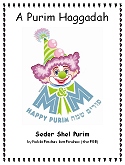|
PURIM IS A HOLIDAY OF IRONY, PARADOX, AND PREPOSTEROUS HUMOR, the very opposite of the solemnity that attends Yom Kippur (the Day of Atonement). Nonetheless the sages connect the two holidays by saying that Yom Kippur is called Yom Kip-purim in the Torah (ūÖūĢų╣ūØ ūøų╝ų┤ūżų╝ų╗ū©ų┤ūÖūØ), which can be read as Yom Ke-Purim, a "day like (ūøų╝) Purim (ūżų╝ų╗ū©ų┤ūÖūØ)." Just as on Yom Kippur we afflict ourselves on orders of the Holy One, so on Purim we are commanded to rejoice (Esther 9:22). "Even if Satan runs amok in the streets, you have to be happy; it is the will of God." The similarity of the two holidays turns on our level of passion: just as we "put our hearts into" doing teshuvah during the time of Yom Kippur, so are we to "put our hearts into" rejoicing during the time of Purim.
In addition to the general carnival-like atmosphere of Purim, some people put on a farcical 'Purim Seder,' complete with a 'Purim Rabbi' (or seder leader) officiating and generally making a mess of things.... Seder guests usually arrive in costume or with their faces painted. The incongruity is often quite hilarious, especially if some of the seder participants are unsure of how to behave themselves...
The table will be set similarly to that of a Passover table, though the "seder plate" will be filled with candy and other items used in Mishloach Manot. For instance, the plate may contain gummy bears, chocolate covered pretzels, boxes of raisins, and so on. Goblets are filled with "soda pop" (i.e., strong drink) and a covered plate of hamantaschen (ūöū×ū¤ųŠūśūÉųĘū®ū¤) is placed on the table before the guests. The "Purim Rabbi" functions as the seder leader who welcomes everyone to the table and gives each a Purim Haggadah. He usually opens the service by giving a small speech before the plate of hamantaschen.
For example:
- Differing opinions exist as to the orecise size of the hamantaschen. All agree they must minimally be the size of Haman's ear, but halachic sources differ as to the exact size of his ears. The Shulchan Aruch holds that Haman's ear was the same size as our ears today, and hence, each of the three sides of the triangular hamantaschen must be 2 inches long. The Mishnah Berurah holds that Haman had especially large ears, and sets the length of each side of the hamantashen at 3 inches. The Chazon Ish, however, states that back in ancient Persia, peoples' ears actually reached all the way down to the floor, and therefore holds that the hamantashen must be 6 feet long per side. At any rate, it is a mitzvah to eat at least two of these ears now, and so we shall begin... (Adapted from the Purim Hagadah, Beis Maxwell Edition)
After the rabbi's speech, the hamantaschen are uncovered and everyone "oohs and aahs." All the seder participants then recite the following prayer together:
"This is the triangular bread, which our forefathers ate in the land of Persia. Let us remember the days of Purim as we were commanded." Let us recite the blessing: (all recite): 'Blessed art thou, our G-d, who hath commanded us on the mitzvah of eating hamantaschen.' Amen."

The seder leader then breaks the topmost hamantash down the middle. A child takes the bigger half and hides it somewhere in house (hopefully, it will be found by Passover). Everyone eats a hamantash (ideally in a single gulp) and sips some soda....
Parodies of other Passover Seder elements are usually employed during the Purim Seder, such as reciting the ten names of Haman's sons who were hanged. As each name is read, we shed "crocodile tears" and remember to take no joy in the destruction of the wicked. It is customary to dip one's finger into the middle of the hamantash, take out a small bit of filling, and wipe the filling on a napkin, symbolizing the burial of each of Haman's sons.
Purim is a time of irony and fun, and the spirit of the holiday allows us to have some fun at the expense of our religious pride and sense of self-importance. After all, we must learn to not take ourselves too seriously. Paul wrote, "Let no one deceive himself. If anyone among you thinks that he is wise in this age, let him become a fool (╬╝ŽēŽüßĮ╣Žé) that he may become wise" (1 Cor. 3:18, Gal. 6:3). Paul even regarded himself as a "fool for Messiah's sake" (1 Cor. 4:10). Among other things, the story of Purim attests that "God has chosen the foolish things of the world to confound the wise; and God has chosen the weak things of the world to confound the mighty (1 Cor. 1:27).
Note: Of course we do not do the "ad lo yada" part of the Purim "seder" -- i.e., getting so drunk that we can't distinguish between the name "Haman" and the name "Mordechai," but the point remains the same: there is a place for some humor in our salvation experience, chaverim.... and may God give us the wisdom to discern such matters. Amen.
To be continued, IY"H...
|


